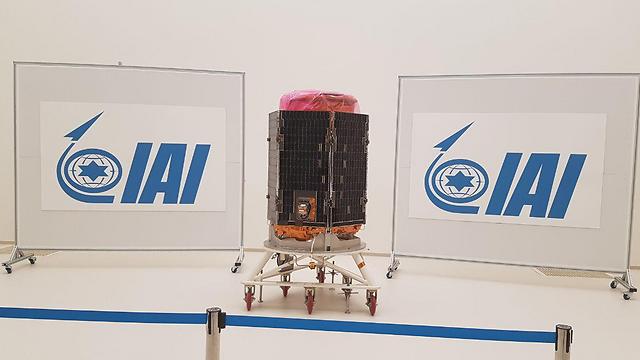

Israel to launch two satellites into space this week
For the very first time, two Israeli satellites will be launched into space together, including the first governmental research satellite; Director General of the Israel Space Agency at the Ministry of Science, Avi Blasberger: 'Several countries are interested in our observation satellites.'
In 1984, Avi Blasberger was one of the first engineers at the Elop company, now owned by Elbit Systems, transferred to working on a top secret project: developing the camera for Israel's forthcoming spy satellite, a capability only possessed by the US and the USSR at the time.
"Years later, a South Korean delegation visited us and asked who taught us to build satellites," recounts Blasberger, now the director of the Israel Space Agency. "I said we learned it from books, and they said that was impossible. Nevertheless, they ended up buying a camera for their observation satellite from us."
In the early hours of this coming Wednesday, the Israel Space Agency will launch two satellites into space from the French launch center in Koro, New Guinea—OptSat 3000, a spy satellite purchased by the Italian ministry of defense, and the Venus research satellite. This marks the first time two Israeli satellites—that aren't microscopic nano-satellites—are launched simultaneously.
NASA has launched dozens of research satellites. What can Venus do that we haven't already seen?
"Venus will be used by precise agriculture and environmental studies researchers. It's equipped with a state-of-the-art camera developed by Elop, which is able to snap photos at 12 wavelengths. 110 sites were selected, which will be photographed by Venus once every two days, a repetition of relatively high frequency no other satellite possesses. Alongside its scientific mission, however, is also an engineering one—to test an electrical propulsion system developed by Rafael, which will someday allow observation satellites to circle more closely to Earth, thereby improving the sharpness of their images—something which has vast commercial potential. In the first two and a half years, the satellite will circle Earth at an altitude of 700 km, then dropping down to 410 km where the new propulsion system will be tested."
The proverbial old lady lying in the hospital hallway would like to know how Israel can afford research satellites when it's short of funds in so many other places.
"Research satellites move both industry and science forward. Investment in the field of space is returned 5 or 10 times over. It creates technologies that may then be sold for various commercial applications. Israel already has several start-ups related to outer space. Scientific research will also contribute to agriculture and improve the use of water, also paving the way for educational projects. This field, anywhere in the world, is reliant on governmental investment, and what Israel invests in this field is infinitesimal even compared to its population size and GDP. Our technological capabilities in space are some of the most advanced in the world. The French space agency, which has partnered with us on this project, is responsible for the satellite camera and has chosen an Israeli supplier—which is quite out of the ordinary—thanks to our capabilities and financial bid."
After Venus, what's next?
"We're working on a new flagship project with the Italian space agency, the Shalom satellite which is hyper-spectral, meaning it can take photos at more than 250 wavelengths and not just 12, like Venus, and embodies the future of observation satellites. The Italians already have the funds, while we're still in talks with the Ministry of Finance, the sum in question being 80 million euro per country. We're hoping to start the project by 2018 and launch four years after that.
"In the meantime, the future of manufacturing communication satellites in Israel is in question, after losing Amos-6 when its launch missile exploded and the hardships faced by the Israel Aerospace Industries to compete with other bids when it comes to costs and timetables for manufacturing Amos-8.
"After losing Amos-6, Minister of Science (Ofir) Akunis created a committee which decided the state should invest NIS 100 million annually in infrastructure for building communication satellites in order for it to be possible to produce parts for them, which today are being purchased abroad. Israel needs blue-and-white satellites operated by Israeli companies. We've since been in negotiations with the Ministry of Finance and now dealing with pretty low sums."
The company that operates the Amos satellites is owned by Shaul Elovitch , who's facing an ongoing investigation into his dealing as majority shareholder of Bezeq. Can it still purchase satellites?
"When the committee I mentioned was created, the Elovitch affair hadn't gone public yet. We continue operating without taking this aspect of it into account. The bottom line and very real need of the space industry still exist, one way or the other."
Astronaut Ilan Ramon went into space in the Columbia shuttle and perished in 2003. Will we see another Israeli astronaut?
"We certainly hope so, but there isn't a specific plan in place at the moment. The number of opportunities for launch has dramatically decreased since the American space shuttle program was scrapped. Today astronauts are only launched to the international space station, and only from countries that are partners to its operation. The director of NASA has already stated that the future mission to Mars will be open to other countries, and that Israel is one of the candidates. But that's not something that's going to happen anytime soon.
"However, Israel may get to Mars even without a local astronaut. In 2019, the Orion spaceship built by Lockheed Martin for NASA will be launched. It's supposed to be used for prolonged space missions and, in the future, a mission to Mars. These missions increase the need for protecting the crew from radiation. A protective suit developed by the StemRad company operating out of Tel Aviv under Dr. Oren Milstein will be tested onboard the Orion. During the spaceship's first flight, which won't be manned, the suit will be test-worn by a state-of-the-art test dummy, assisted by the German space agency. StemRad has developed a suit that's more ergonomic than those currently on the market and that also better protects against radiation relative to its weight. It focuses exactly on the areas under the most risk."
Our advantage in the Middle East is constantly eroding: Iran is already building and launching satellites.
"Iran has proven it possesses launch capabilities. It's willing to invest large sums of money and is closing some of the gaps. However, by my estimate our technologies are still more advanced. Access to space is a significant aspect of the rivalry between countries, among other things due to the double uses technology has in civilian and military sectors. We can and should invest more."
















